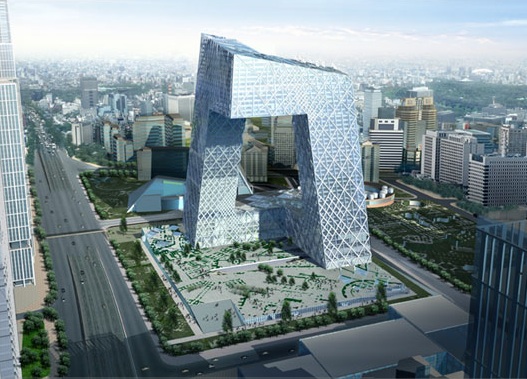Rem Koolhaas's architectural practice OMA have been building the highly complicated, iconic building for the headquarters of China Central Television (CCTV) and its adjacent Television Cultural Center (TVCC) in the new CBD (Central Business District) of Beijing, China.* The building does not only fascinate with its innovative architectural elements but is also championed for its structural achievements on a site of seismic activity.
Spread over a 20 hectares of land, the CCTV building will supply 465.000 m2 space despite its relatively low-height for a growing CBD skyscraper at 234 metres. While the form of the building tries to interconnect various activities at the site such as administration, production and broadcasting, its social and spatial implications are also regarded as being "completely rethought to provoke a new kind of collective construct with the potential for social and urban change" (Tina di Carlo). Initially aimed to be completed by the 2008 Oympic games, the building will be open only after the final torch is put off at Herzog & de Meuron's "Bird's Nest". However, what will match the architectural excellence of this building has already been masterminded by the politicians in the form of social and political regulations of surveillance.
CCTV is better known as an abbreviation for a technical term familiar to most London and British citizens: Closed-circuit television. There is no consensus on the exact number of CCTV cameras in London, numbers vary from 10,000 crime-fighting cameras to 500,000 public+private surveillance cameras in London to a staggering 2 Million all around the UK. Anna Funder in Stasiland has argued that there were around 50 Stasi informers for every citizen in the DDR (East Germany), comparing it to 1/300 for Russian KGB. I had likened this to the Second Constitutional Period of the late Ottoman Empire. An estimation of 500,000 cameras in London would suggest 1 camera per 14 people in this city.
This is not to suggest that DDR citizens enjoyed a lifestyle the British enjoy today. There's a fine article, followed by some fine comments (look for the comment by Koolio) in the Guardian newspaper website. Nonetheless, I'd imagine east Germans feared from more tangible suspects, e.g. a weirdo-looking neighbour who seems to set an eye on your wife (or even your dog) whereas he's trying to track every single move in your household. In comparison, Londoners today are forced to think today that they fear from a terrorist-act that will come flying over from people of distant lands, descendants of many they actually have had the opportunity to live together for long decades. In a unique and bizarre sense, the liberal and imperial experience of Britain helped its citizens towards a much wider and open perspective towards other cultures, while its political agenda planted seeds of extreme surveillance. In the meanwhile, China is coping with its global agendas looking towards its western counterparts...
It makes little wonder that the OMA received service for Broadcast Consultancy from a London firm for the CCTV project. In the southern China city of Shenzhen, 20,000 police surveillance cameras have already started supplying the monitors in OMA's architectural masterpiece with constant footage as well as information on work history, educational background, religion, ethnicity, police record, medical insurance status and landlord’s phone number of citizens thanks to a clever data chip.
After the re-unification of Germany, a special institution created by the federal state, "Federal Commissioner for the Records of the State Security Service of the former German Democratic Republic" has been holding the inspection files created on former DDR citizens. People have been enjoying their right to go to the archives and read what had been written about them since 1990. These have been inspirational resources to many literature and cinema production on the issue, and helped the likes of beloved Ulrich Muhe who has read his own Stasi files before going on to act as Captain Gerd Wiesler in Das Leben der Anderen. Whether the British or the Chinese will go through similar processes, may the occasion arise is beyond my knowledge, but the visual aura created by the impressive CCTV building in Beijing will be accompanied by the visual data within itself and the "social change" (referred to above) that is taking place in China.
To wrap all of this up, we can refer one last time to Anna Funder's experiences in the East German television station at Adlershof, Berlin. This place has been transformed into a new multimedia centre since the time of Funder's writing, but she was lucky enough to feel the never-ending corridors consisting of identical rooms on each side of it, that could only be distinguished by the function they were serving: control room, production room, filming room, etc... The simple modernist architecture of the East German television centre held the archives of propaganda programmes like "The Black Channel". Simple-minded surveillance and propaganda of the DDR made no fuss about architectural extravaganza like in the times of neo-classical, heroic style of the Nazis, or the current ground-breaking form depicted in Beijing's CCTV. After all, more and more cities like Shenzhen, Beijing or London transform into open-air panopticons (although they are not designed as such, but rather transformed into) enforcing an indirect discipline in a Foucaldian sense. Iconic architecture remain well-seated in the midst of it, continuing to amaze citizens of these "open cities".
* A funny side note is the interplay of abbreviations: OMA together with its research centre AMO are building CCTV and TVCC next to each other.




2 comments:
At last an English version of your blog :)
Btw, check out Stafford Beer's "Designing Freedom"!!!
George
=) There have already been a few more English entries earlier. Thanks for reading.
Thanks for the great advice, our library seems to have it as well! =)
Post a Comment